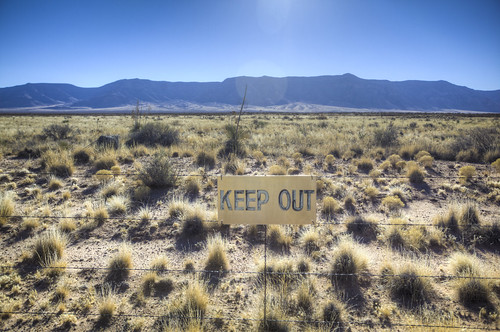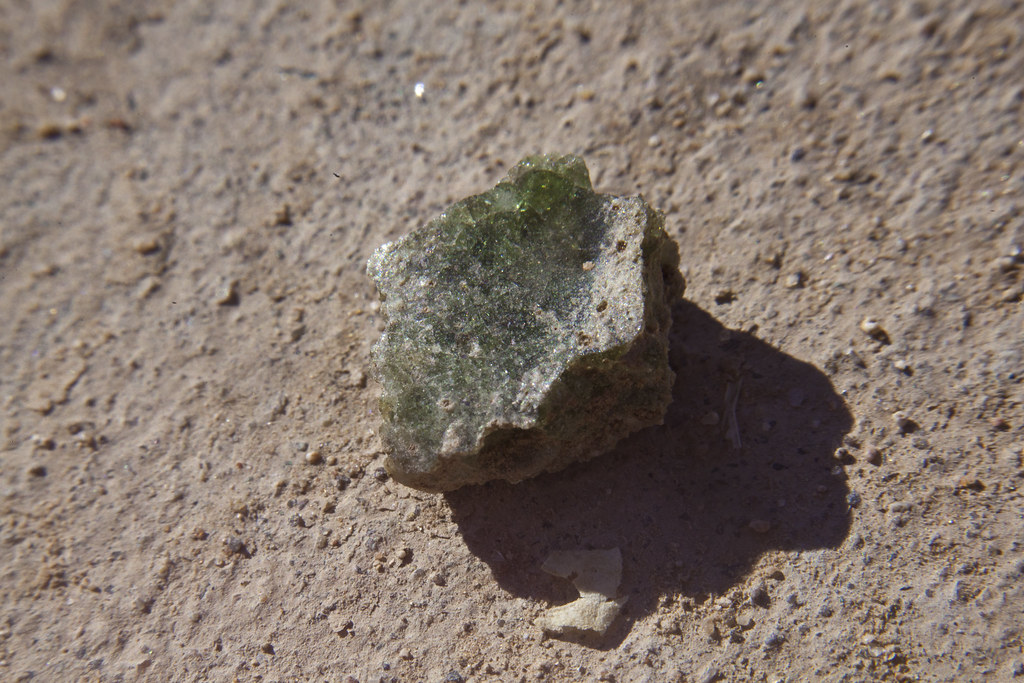The Trinity Historic Site is located within the White Sands Missile Base between Socorro and Alamagordo, New Mexico and is a study in understatement. Entering the base from the north, we were greeted by an alien species to me: enthusiastic African American volunteer man of which I’d encounter 3 that day. The wait to enter the facility took about 15 minutes and getting lost was nearly impossible as every intersection was physically barricaded for all routes that didn’t lead to the test site. Cars were wedged in and the site and path to it were ringed by fencing with pronounced “keep out” signs making deviation tough.
The hypocenter of the Trinity explosion is marked by a lava stone obelisk that commemorates “The Gadget” being tested and the onset of the atomic age. In 1952 the site was bulldozed and the trinitite was “disposed of” which explains the distinct lack of features of the area where the 20 kiloton device went off. The contrast of the lava rocks and the brilliant sun makes me think that very few pictures of people posing with the memorial came out well, thus I cheated and used HDR.
Steve has a shot of me licking the monument. I’m not terribly worried about germs and the like as the lava rock probably exceeds autoclave temperatures at the height of the heat of the Jornada de los Muertos desert and besides, I’m not sure many other people have done the same. Ringing the site were information placards about the test and who did what, but I thought this was poorly done. The operations of the Manhattan Engineering District eventually employed 130,000 people at a cost of about $2bn while the photos and museum plates made it look like a weekend project done by some local nerds and their army buddies. At the end of the arc, near an instrumentation bunker, there were scattered pebbles that without sign or fanfare and only because of their green color would one register them as trinitite, the witnesses of history.
You may think be a fool to reverse mount a lens in an environment this dusty but I consider any sensor damage worth it. The color made the pieces look like they were part of a neolithic sprite bottle and no effort was made to secure the pieces from theft.
The McDonald ranch was where the plutonium core was assembled and both its time as a farmstead for the Schmidt family and construction point for a nuke are documented. The destroyed windmill made the site almost looked staged, serving as a reminder to the viewer of this place having not been used since the long ago. While the blast destroyed the windows and some of the barn, the farm house itself took much more of a beating from the elements.
I had my time with history, and we made our way to the Very Large Array, again stopping in Socorro, New Mexico for lunch. As if to emphasis how much yesterday sucked, the Arby’s in Socorro had diet peach iced green tea and I consumed about a 1/2 gallon of it before topping off my drink vessel and heading into the west to see big science.
There are no factual inaccuracies in the term “Very Large Array”, it is an array, and it is very large. After passing the entrance a number of time we hit the locus of the field of science where 27 dishes do a dance capable of the radiographic equivalent of resolving the date on a dime across the planet. The Very Large Array does not have a gaudy entrance and a lone person directed cars next to a building with an obligatory gift shop and list of all the sciency films the VLA had been in and a stream of people reached escape velocity and went from there to the tour start location.
The tour was led by a reasonably avuncular fellow who showed us how the VLA’s transition from waveguide tubes to fiber optics had increased data throughput by some ungodly amount to which an audience member said “so, you’re only three generations behind, now?” Everyone laughed but as we shuffled on the person’s son looked up and said “dad, you made the scientist feel bad”. We were shown the work the VLA did and how projects are allotted but there was one piece of exquisite engineering in plain sight:
The second story balcony gave a nice view of the whole area:
The Very Large Array is a triumph in instrumental efficiency with hot queueing that allows for experiments to be rotated as conditions change and with a downtime annually measured in hours due to an emergency response crew that can be on site in 30 minutes.   All and all the project was explained as costing “less than one F-16” which at least sounds like a good usage of NSF funding. The dishes were nice in an array, but I think they become almost like cathedrals up close:
I asked the guide if there were such things as a adaptive optics for radio antenna, he said that the closest they come is manually deforming the surface of a dish with a mallet to modify panels and deal with new persistent radio buzzes. Seems very practical.
Our final stop was Bosque Del Apache which contains some of the best opportunities for bird photography in the US. We went during a season where there were no birds and got a lot of this:
Normally, you’d see a picture here, but I found none to be all that impressive and none includes a bird that wasn’t mooning the camera. So, I guess I’ll just leave the hanging colon as a reminder of how much a national flyway can suck when there’s no flying. The rage powered me back to Steve’s place where we ended the night.







